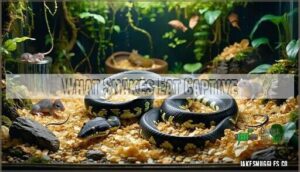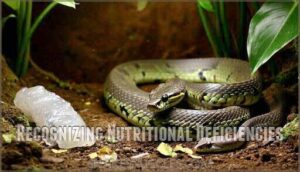This site is supported by our readers. We may earn a commission, at no cost to you, if you purchase through links.
 In captivity, you’ll feed your snake whole prey animals that mirror their natural diet.
In captivity, you’ll feed your snake whole prey animals that mirror their natural diet.
Most pet snakes thrive on frozen-thawed rodents like mice and rats, which you’ll size according to your snake’s girth.
Ball pythons prefer mice, while larger species like boas need rats or rabbits.
Fish-eating snakes require whole fish, and some species enjoy chicks or quail.
You’ll typically feed juveniles weekly and adults every 2-3 weeks.
The key is matching prey size to your snake’s widest body part – too small won’t satisfy them, too large creates health risks.
Proper feeding isn’t just about what you offer, but timing and technique matter just as much.
Table Of Contents
- Key Takeaways
- Snake Captivity Diet
- What Snakes Eat Captive
- Feeding Snake Variations
- Snake Feeding Schedules
- Snake Feeding Best Practices
- Frequently Asked Questions (FAQs)
- What do you feed a pet snake?
- Do snakes eat in captivity?
- How often do snakes eat in captivity?
- What do zoos feed snakes?
- Can snakes eat eggs instead of rodents?
- How long can snakes go without eating?
- Do snakes need water during feeding?
- Can captive snakes eat insects exclusively?
- Should I feed my snake during shedding?
- Can snakes eat frozen-thawed prey safely?
- Conclusion
Key Takeaways
- Size your prey correctly – Choose prey that’s slightly smaller than your snake’s thickest body part and equals 10-15% of their body weight to prevent digestive issues and ensure proper nutrition.
- Feed according to age – You’ll need to feed juveniles weekly, while adults only need meals every 2-3 weeks, adjusting frequency as your snake matures.
- Use frozen-thawed whole prey – Stick with pre-killed rodents, like mice and rats, rather than live prey to eliminate injury risks while providing complete nutrition your snake needs.
- Match diet to species – Ball pythons thrive on mice and rats, while some species, like garter snakes, need fish, and king snakes accept varied prey, including eggs and chicks.
Snake Captivity Diet
Feeding captive snakes properly requires understanding their specific nutritional needs and natural hunting behaviors.
You’ll need to provide whole prey items that match your snake’s size and species requirements for ideal health.
Nutritional Needs
Understanding your captive snake’s nutritional needs guarantees proper health and longevity.
Snakes require specific nutrients that mirror their wild diet for ideal development and immune function.
- Protein Sources – High-quality whole prey provides essential amino acids
- Vitamin Supplements – Occasional supplementation prevents deficiencies in captive environments
- Mineral Requirements – Calcium and phosphorus ratios must balance for bone health
- Caloric Intake – Energy needs vary by species, age, and activity level
- Dietary Balance – Complete nutrition comes from varied, appropriately-sized prey items
Whole Prey Importance
Throughout snake evolution, whole prey items have provided balanced nutrition that processed snake food options can’t replicate.
Your captive snake diet benefits from this natural approach because whole prey contains essential nutrients in proper ratios.
Fresh food like whole mice or rats delivers vitamins, minerals, and calcium from bones that support healthy growth.
Wild diet patterns show snakes consume entire animals, making whole prey the gold standard for pet snake feeding and ideal snake care nutrition.
Understanding proper captive snake diet is vital for maintaining healthy snakes in captivity.
Prey Size Considerations
Getting prey size right makes or breaks your captive snake diet success.
Perfect prey size prevents feeding failures and health problems.
You’ll need precise prey measurement to avoid digestive issues or nutritional gaps.
Follow these feeding guidelines:
- Girth Rule: Choose prey slightly smaller than your snake’s thickest body section
- Weight Formula: Prey should equal 10-15% of your snake’s body weight
- Size Variance: Adjust portions based on species, age, and meal frequency needs
Proper portion control prevents overfeeding while ensuring adequate snake care nutrition for healthy growth.
What Snakes Eat Captive
Captive snakes thrive on whole prey items that mirror their natural hunting instincts.
You’ll find that most pet snakes do best with rodents—mice and rats being the gold standard for reptile nutrition.
These prey animals provide complete nutrition, including bones for calcium, organs for vitamins, and muscle for protein.
Your snake’s menu isn’t one-size-fits-all.
Ball pythons love mice and rats, while corn snakes accept similar options but in smaller sizes.
Some species need variety—king snakes might eat other snakes, and certain species require birds or fish.
Understanding proper snake feeding techniques is vital for their health and well-being.
| Snake Species | Primary Food | Alternative Options |
|---|---|---|
| Ball Python | Frozen/thawed rats | Mice (juveniles) |
| Corn Snake | Frozen/thawed mice | Small rats (adults) |
| King Snake | Mice/rats | Other snakes, lizards |
| Milk Snake | Mice | Small birds, eggs |
| Boa Constrictor | Rats/rabbits | Guinea pigs (large adults) |
Pre-killed frozen prey is safer than live feeding and eliminates injury risks.
This approach to feeding captive snakes guarantees your exotic pet gets proper nutrition without the drama of live hunting.
Feeding Snake Variations
You’ll need to tailor your snake’s diet based on its species, natural habitat, and age.
Different snakes have evolved unique feeding requirements that you must understand to keep them healthy in captivity.
Species-Specific Diets
Different snake species have unique Prey Selection requirements based on their natural feeding habits.
Each snake species demands its own specific prey – one size doesn’t fit all reptiles.
Ball pythons thrive on rodent-only diets, while king snakes accept varied prey including eggs and chicks.
Garter snakes need fish and amphibians alongside mice.
Your snake’s Species Diets determine proper Feeding Strategies – arboreal species often prefer birds, aquatic types require fish-based Snake Nutrition for peak health.
Understanding the proper ball python care is essential for creating effective feeding plans.
Habitat Influence on Diet
Environmental factors shape what your snake will eat through habitat design.
Complex enclosures with varied substrates and enrichment boost foraging behaviors and dietary adaptation.
Your setup directly impacts food availability and ecosystem dynamics within the habitat.
Naturalistic environments encourage broader prey acceptance, while simplified habitats restrict feeding responses.
Habitat diversity drives better snake eating habits and supports thorough reptile food sources for ideal snake nutritional needs.
Providing adequate reptile enrichment strategies is essential to promote healthy eating habits in snakes, which is influenced by the overall ecosystem dynamics.
Age-Based Dietary Needs
Your snake’s age determines everything from meal size to feeding frequency.
Hatchling diet requires tiny prey every 4-7 days, while adult meals happen weekly or bi-weekly.
Here’s what changes as your snake grows:
- Hatchlings need frequent small meals – pinkies every few days fuel rapid growth
- Juveniles graduate to larger prey – fuzzy mice match their expanding girth
- Adults eat less often but bigger – adult rodents every 1-2 weeks maintain health
Senior care involves smaller, more frequent meals as metabolism slows.
Snake Feeding Schedules
Creating a proper feeding schedule guarantees your snake stays healthy and maintains prime body condition throughout its life.
You’ll need to adjust both frequency and prey size based on your snake’s age, species, and individual growth rate.
Age-Based Feeding Frequency
Your snake’s age dictates how often you’ll feed them.
Hatchling diet requires meals every 5-7 days to fuel rapid growth rates.
Juvenile feeding shifts to 7-10 day intervals as metabolism slows.
Adult nutrition needs only occur every 10-21 days.
This snake feeding schedule reflects natural feeding cycles, making your captive reptile care more effective and preventing overfeeding issues.
Remember that seasonal changes can also affect appetite.
Prey Size Guidelines
Proper prey size guarantees your snake’s health and prevents feeding complications.
Use prey measurement guidelines where food items equal 10-15% of your snake’s body weight.
Feeding charts help determine appropriate food portions as your snake experiences growth phases.
Captive diets require precise sizing – too large causes regurgitation, too small provides inadequate nutrition.
Snake feeding requirements vary by species and age.
Feeding Response Stimulation
Success in feeding reluctant snakes requires understanding their natural hunting instincts.
When your snake shows food aversion, these proven techniques can trigger their stimulus response:
- Movement mimicry – Use tongs to create lifelike prey motion
- Scent enhancement – Apply familiar odors like fish or bird scents
- Temperature optimization – Warm prey to body temperature before offering
- Environmental darkness – Feed nocturnal species in complete darkness
These sensory stimulation methods activate hunger signals effectively.
Snake Feeding Best Practices
Proper feeding technique forms the foundation of successful snake husbandry and prevents most nutrition-related health problems.
You’ll need to master prey handling, recognize feeding cues, and maintain consistent schedules to keep your snake healthy.
Handling and Feeding Techniques
Using feeding tools like tongs prevents accidental bites during prey presentation. Hold your snake gently but securely when needed, keeping movements slow and deliberate.
Present pre-killed prey at proper temperatures to trigger natural feeding responses in captive environments. When selecting equipment, consider using feeding tongs options to guarantee safe and efficient feeding.
| Feeding Tools | Snake Handling | Food Presentation |
|---|---|---|
| Long feeding tongs | Support body weight | Room temperature thawing |
| Hemostats for precision | Avoid sudden movements | Warm prey slightly |
| Protective gloves | Handle post-feeding carefully | Present head-first |
| Secure enclosures | Minimize handling time | Use feeding chambers |
| Emergency supplies | Watch for defensive postures | Monitor feeding response |
Avoiding Overfeeding and Underfeeding
Many reptile owners struggle with food quantity – it’s like walking a tightrope between too much and too little.
Monitor your snake’s body condition weekly, feeling for visible ribs or excessive fat deposits. Follow established feeding schedules based on species and age, adjusting portions when weight management becomes necessary.
Proper snake nutrition depends on consistent feeding guidelines rather than guesswork.
Effective snake care also involves understanding proper weight management techniques to guarantee the health of the snake, which is crucial for proper snake nutrition and overall snake care with effective weight management techniques.
Recognizing Nutritional Deficiencies
Four key malnutrition signs indicate serious dietary imbalance in your snake.
Watch for neurological symptoms like tremors or apparent blindness, which often signal thiamine deficiency from poor-quality frozen fish. Weight loss and lethargy suggest nutrient deficits requiring immediate attention.
- Neurological changes – Ataxia, seizures, or vision problems from vitamin deficiency
- Physical deterioration – Weak bones, poor shedding, or slow wound healing from feeding disorders
- Behavioral shifts – Decreased activity, feeding refusal, or reproductive issues from systemic malnutrition
Frequently Asked Questions (FAQs)
What do you feed a pet snake?
You’ll feed your snake whole prey items like frozen-thawed rodents.
Young snakes need pinkie mice weekly, while adults eat adult mice or rats monthly.
Choose prey that’s slightly wider than your snake’s thickest body section, considering the snake’s size and the prey.
Do snakes eat in captivity?
Your ball python Jake refuses meals for months during winter brumation, yet thrives perfectly fine.
Yes, captive snakes eat, but they’ll often fast naturally for weeks or months depending on species, season, and individual needs.
You’ll provide pre-killed prey.
How often do snakes eat in captivity?
Young snakes need food weekly, while adults eat every two to four weeks. You’ll notice they’re less active before feeding time and more alert afterward, making timing easier to judge.
What do zoos feed snakes?
Zoos provide snakes with whole prey items, pre-killed frozen rodents, and specialty diets. You’ll see them offering mice, rats, rabbits, chicks, and fish depending on species size and natural preferences.
Can snakes eat eggs instead of rodents?
Yes, many snake species can eat eggs as their primary diet.
Egg-eating snakes like Dasypeltis species thrive on bird eggs exclusively.
You’ll find some pet snakes, including certain rat snakes and kingsnakes, readily accept quail or chicken eggs as nutritious alternatives to rodents, which is a key aspect of their primary diet.
How long can snakes go without eating?
Patience is a virtue" rings true with snakes—you’ll find most species can survive weeks to months without food.
Adult snakes typically fast 2-6 weeks safely, while juveniles need feeding more frequently due to their rapid growth requirements, which makes patience a necessary trait for their care.
Do snakes need water during feeding?
Snakes don’t need water during feeding.
They get moisture from their prey and can go weeks between drinking.
However, always keep fresh water available in their enclosure for hydration between meals.
Can captive snakes eat insects exclusively?
While massive pythons devour whole rabbits, tiny insectivorous species like rough green snakes can’t survive on bugs alone.
You’ll find most captive snakes need rodents, birds, or fish as primary food sources since insects lack essential nutrients for proper growth, and this highlights the importance of a diet that includes fish.
Should I feed my snake during shedding?
Don’t feed your snake during shedding periods.
Their appetite naturally decreases, and they may refuse food anyway.
Wait until the shed is complete before offering meals to avoid stress and potential regurgitation issues.
Can snakes eat frozen-thawed prey safely?
Yes, you can safely feed frozen-thawed prey to your snake. It’s actually safer than live prey since it eliminates injury risk from struggling rodents. Thaw completely in warm water first.
Conclusion
Mastering what do snakes eat in captivity transforms you from novice keeper to confident caretaker.
You’ve learned proper prey sizing, feeding schedules, and species-specific requirements that guarantee your snake’s health.
Remember that consistency beats perfection – missed meals won’t harm healthy adults, but regular overfeeding will.
Trust your snake’s natural feeding responses and body condition.
With these fundamentals, you’ll provide nutrition that supports long, healthy lives for your captive serpents.
- https://links.e.response.mayoclinic.org/EmailPreview-GeneralHealth
- https://mcforms.mayo.edu/mc5200-mc5299/mc5256-01.pdf
- https://www.petmd.com/reptile/ball-python-care-sheet
- https://www.evolutionreptiles.co.uk/blog/feeding-corn-snakes-preventing-obesity-and-promote-healthy-nutrition/
- https://www.zenhabitats.com/blogs/reptile-care-sheets-resources/how-to-add-variety-to-your-snakes-diet-zen-habitats














